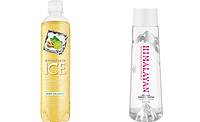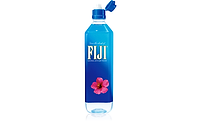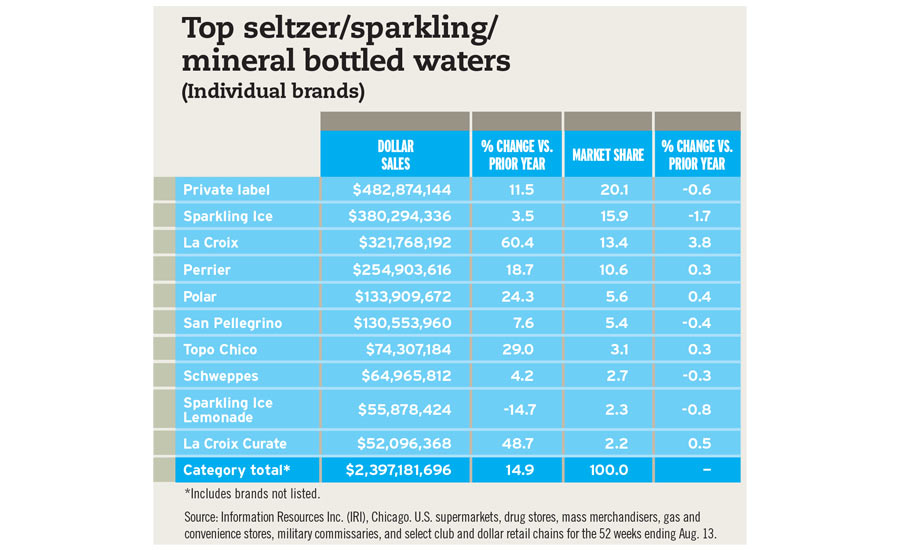Bottled water growing, but at decelerated pace
Sparkling, imported, enhanced waters benefit bottled water category








Thriving on its healthy halo, natural and better-for-you attributes, bottled water has experienced unprecedented success during the past few years. Last year, the category overtook carbonated soft drinks (CSDs) as the most-consumed beverage category on a volume basis.
“2016 marked a watershed moment in the U.S. soft drinks industry as bottled water finally overtook carbonates in sales volumes to become the most-consumed soft drink in the country,” states Chicago-based Euromonitor International in a February report titled “Bottled Water in the US.” “Consumers continued to exit the carbonates category because of health concerns about sugar and artificial sweeteners, turning instead to bottled water as a healthy way to stay hydrated. With public health concerns about sugar remaining high, these trends are unlikely to reverse anytime soon.”
In the past year, the bottled water category has continued to grow, but has experienced slower growth rates as a result of its massive size. Jordan Rost, vice president of Consumer Insights at New York-based Nielsen, notes that the category experienced dollar sales growth greater than 6 percent during the past five years but a slight decline can more recently be seen.
“In the last year, water sales reached a new high of $12.7 billion; however, the growth trajectory has definitely slowed. Where the category was up 9 percent in 2016, today, dollar growth stands at 4 percent,” he says.
Michael Bellas, chairman and chief executive officer of New York-based Beverage Marketing Corporation (BMC), explains that although the category continues to perform well, a deceleration in growth is to be expected.
“It’s not unusual, because that’s a pattern we’ve found with almost all of the [liquid refreshment beverage] (LRB) categories, they’ve slowed somewhat from last year, including soft drinks, fruit beverages, [ready-to-drink] (RTD) teas, RTD coffees, sports beverages especially, and even energy drinks are slowing,” he says. “In total, considering its massive size, it’s still up around 7 percent [by volume] for the first half.
“… What you’ve got to understand is a 7 percent growth rate in a category that is so huge like this, it’s rather dramatic,” he continues. “It’s also from its huge volumetric base, you would expect the growth to just slow a little bit just because the category has such a big base to go up against. In total, it’s slowed, but I still think many categories would love to have the growth of bottled water, especially from such a strong base, the volumetric gain is significant.”
Despite the deceleration, experts note that continued success from the bottled water category is to be expected during the next few years, as all of the segments in the category are displaying positive performance.
“The trajectory for water seems positive, however, with slowed growth rates in the latest year, careful monitoring is key to success,” Nielsen’s Rost says. “Regular monitoring of the category’s performance, how various water variants are purchased similarly to other beverages and continually capitalizing on [the] healthful intentions of consumers will help print continued future success.”
BMC’s Bellas expects that bottled water will continue to set new milestones in the beverage marketplace. “I think it’s got solid growth ahead for a number of years, a little slower and maybe we’ll start to see a gradual slowing of the growth rate going forward, but by sometime, maybe the middle of the next decade, we may see it reach as high as 50, 54, 55 gallons per capita, which would put it ahead of CSDs at its peak,” he says.
Source of growth
Although all of the bottled water segments are positively trending, Bellas notes that one segment in particular is performing especially well — sparkling.
“The key winner is domestic sparkling, which continues to accelerate,” he says. “We’ve got that up about almost 40 percent [by volume] in the first half.”
Double-digit gains continue for sparkling water in regards to dollar sales growth as well, Nielsen’s Rost notes.
“Sparkling water is performing incredibly well, seeing growth of 19 percent in dollars in the latest year,” he says. “As soft drink sales contract, we see consumers filling their cravings for carbonation in the water category. Competition may be close to home as sparkling water exceeds the growth of flat and distilled water.”
Bellas also predicts that the accelerated growth will continue.
“Sparkling waters are going to be growing at double-digits for a long time — for quarters ahead,” he says.
Still waters, however, remain the largest segment of the category, comprising 65.5 percent of the bottled water market, according to Los Angeles-based IBISWorld’s December 2016 report titled “Bottled Water Production in the US.”
However, BMC’s Bellas explains that the total non-carbonated segment of the bottled water market has experienced the largest declines within the overall category, but continues to grow at rates between 5.5 and 6 percent by volume, which compares with 7 percent growth during the previous year.
He adds that multi-packs of single-serve bottles from private label brands have been a bright spot for the segment, up between 10 and 12 percent by volume because of their low price points. Additionally, more mainstream and premium brands are gaining ground as a result of marketing and distribution efforts.
Within both the sparkling and still segments, imported bottled waters are experiencing success, Bellas says. Although imported sparkling waters aren’t performing as well as their domestic counterparts, consumers desire the exotic and premium nature of imported still and sparkling waters.
IBISWorld’s report also notes this trend. “[A] growing number of consumers are demanding imported bottled water that comes directly from remote locations,” it states. “Brands like Fiji Water are increasingly popular among health-conscious bottled water drinkers, which has resulted in growing demand for foreign-bottled waters.”
Imported bottled water sales have increased at an annualized rate of 5.3 percent between 2011 and 2016, it adds.
Also experiencing notable growth, enhanced waters have been another contributor to the category’s overall success, experts say.
“While water segments across the board are experiencing growth, enhanced water stands as the sole variety to avoid plateau, and actually exceeded 2016 growth rates,” Nielsen’s Rost says. “Enhanced water amassed over $2.2 billion in sales this year, marking impressive growth of 8 percent compared to last year.”
He adds that consumers are willing to pay for added value in the bottled water category, noting that more than half will do so.
“Fifty-six percent of Americans say they’re willing to pay more for foods and drinks that don’t contain undesirable ingredients,” Rost says. “Despite the fact that the average price for enhanced water has steadily climbed over the past few years (up 4 percent versus 2016), consumers believe in the nutritional and health benefits of enhanced waters.”
Mintel’s report notes that bottled water can provide a convenient way for consumers to get a variety of health-and-wellness benefits, like vitamins, antioxidants, electrolytes and probiotics.
Fulfilling consumer demand
A confluence of trends is driving much of the growth in the bottled water category.
“Strong consumer interest in water as a health alternative to sugary and caffeinated beverages paired with growth in flavored, sparkling and enhanced offerings have buoyed the market and should be positive drivers through 2021,” states a January report from Chicago-based Mintel titled “Bottled Water – US.”
Nielsen’s Rost also highlights the quantity of consumers who have been drawn to the category.
“When asked about how they’re actively managing their lifestyles, 77 percent of Americans indicate they’re trying to drink more water — this is up 2 percent from 2016,” he says. “The rise we’ve seen in water sales, including enhanced water, goes hand in hand with the notion of water as a health essential. Healthful thinking is reaching new heights, and this has driven the ease to which people are viewing and prioritizing staying hydrated.”
In line with this, Mintel explains that consumers have a variety of need states for which they turn to bottled water. Among them, hydration ranks as the No. 1 reason that consumers look to the category, with 79 percent noting the need state in a study of 1,760 Internet users ages 18 years and older who drank bottled water during the prior three months.
Other reasons included “to quench my thirst,” 70 percent; “it’s better quality than tap water,” 40 percent; “digestive health,” 36 percent; “skin health,” 31 percent; “it’s more convenient to access,” 31 percent; “weight loss,” 28 percent; and “to keep me full,” 28 percent.
However, consumers also are looking for other, sometimes added, benefits from bottled waters. Natural is the top attribute consumers look for in bottled water products, but a variety of other product traits also are in demand, such as vitamin enhanced, electrolyte enhanced, antioxidants, flavors, organic, energy enhanced, containing probiotics, containing protein, as well as coming from a natural, exotic or international source.
“Consumer attitudes show broad-based potential for developing new and improved bottled water products,” the Mintel report states. “Many of these attributes are even more highly sought by those consumer groups most engaged in the category, such as 18- [to] 34-year-olds, parents and Hispanics.”
Sweetened beverage taxes also could be playing a role in consumers’ choice of bottled water, BMC’s Bellas says.
“We think, essentially, the category, both the sparkling and still, is benefiting from those taxes. And, even more globally, with the increasing concern about sugar in beverage intake, water is the perfect beverage,” Bellas explains. “It’s dietetic, it’s all natural, it doesn’t have to be chilled, it doesn’t have to be carbonated, it has a vast array of usage occasions, it has a healthy good-for-you halo, plus it has incredible, especially with the single-serve multi-packs, incredibly low pricing.” BI
Looking for a reprint of this article?
From high-res PDFs to custom plaques, order your copy today!










